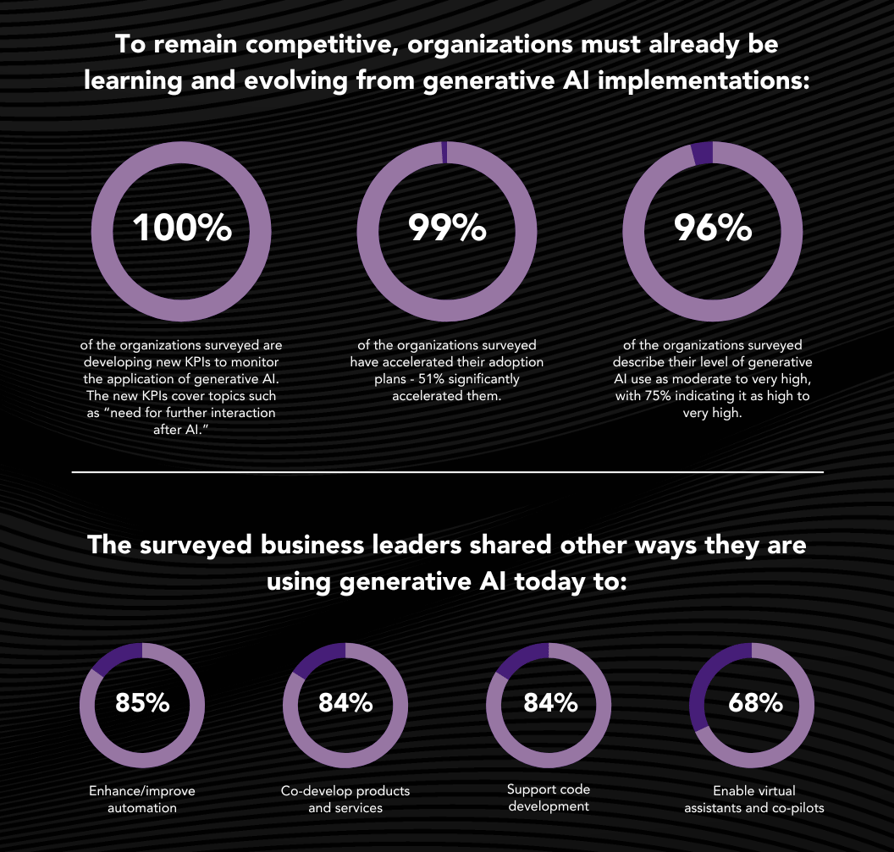In the rapidly evolving digital era, where connectivity and operational efficiency are paramount, the infrastructure terrain is experiencing a profound shift. From the widespread adoption of cloud computing to the emergence of edge computing and the integration of advanced, next-gen technologies like Generative Artificial Intelligence (GenAI) and Machine Learning (ML), the infrastructure ecosystem is witnessing unprecedented advancements. In this briefing, we will explore the pivotal trends and technologies shaping the future of infrastructure, offering strategic insights business leaders can use to guide their organizations through this dynamic landscape.
Before we navigate through the dynamic infrastructure landscape, it is imperative to define the very foundation upon which these technological advancements are built. Infrastructure, in its essence, encompasses the fundamental framework of interconnected systems and resources that enable the seamless flow of data, communication, and operations within an organization or across networks. This consists of physical components like data centers, enterprise networks, hardware, and virtual components like software platforms and cloud services. Understanding the multifaceted nature of infrastructure is essential as we dive deeper into the transformative trends and technological advancements shaping its future. By recognizing infrastructure as the backbone of modern enterprise operations, we can effectively navigate the complexities of this evolving terrain and leverage emerging innovations to drive performance optimization, sustainability, and resilience.
1. Embracing Hybrid Cloud Strategies for Scalability, Flexibility, and Operational Optimization
Cloud computing has transformed the way businesses operate. It has become the linchpin of modern infrastructure, offering unparalleled scalability, flexibility, and cost-efficiency. Whether leveraging Infrastructure as a Service (IaaS), Platform as a Service (PaaS), or Software as a Service (SaaS), enterprises are harnessing the power of the cloud to drive agility and innovation. With the evolution of multi-cloud and hybrid cloud strategies, business leaders can optimize their infrastructure investments, balancing performance, security, and compliance requirements effectively. Hybrid cloud strategies have become the cornerstone in modernizing organizational infrastructure offering unparalleled scalability, flexibility, and driving operational optimization. Through seamless integration of private and public cloud environments, organizations can dynamically allocate workloads based on changing demands allowing them to always ensure optimal resource utilization while maintaining stringent security standards. This hybrid approach empowers businesses to scale their operations efficiently, leveraging the virtually limitless resources of the public cloud for peak workloads, while retaining sensitive data and mission-critical applications within the confines of their private infrastructure. This flexibility enables agility for organizations to respond quickly to evolving market conditions and customer demands. Moreover, hybrid cloud architectures facilitate operational optimization by enabling automated workload orchestration, streamlining of deployment processes, and enhanced resource management leading to reduced costs and maximizing efficiencies across their entire IT landscape. As organizations continue to embrace hybrid cloud strategies, they position themselves to maintain a competitive advantage in an ever-evolving digital ecosystem where adaptability and agility are paramount for sustained success.
2. Unlocking Competitive Advantage with Edge Computing
In an era characterized by the proliferation of IoT devices, the urgency for real-time data processing and low-latency applications intensifies across industries. Enter edge computing – a transformative paradigm that decentralizes processing power and pushes it closer to the data source, enabling faster decision-making and enhancing operational efficiency. From enhancing customer experiences to optimizing supply chain management, edge computing presents a strategic opportunity for business leaders to unlock new revenue streams and gain a competitive edge in their respective industries. By deploying edge computing solutions, organizations can achieve unprecedented levels of responsiveness and efficiencies in diverse applications.
Edge computing is revolutionizing how organizations process and utilize data. For instance, in manufacturing, edge computing enables predictive maintenance by analyzing sensor data in real-time, minimizing downtime, and optimizing production schedules. Similarly, in retail, edge computing powers personalized customer experiences by processing data from in-store sensors to deliver targeted promotions instantly.
Edge computing is also helping to improve overall system performance:
- By decentralizing computational tasks and distributing them across edge devices, tremendous benefits are achieved by applications that require high-speed processing.
- Areas of the network where bandwidth optimization is crucial are benefiting from edge computing through the reduction of volume of data transmission to centralized servers or the cloud and by alleviating network congestion.
Edge computing is also enhancing security and privacy:
- With edge computing, the need to transmit sensitive data over networks is minimized through the ability to process it locally. This reduces the risk of data breaches and ensures compliance with regulatory requirements.
Overall, this strategic adoption of edge computing is invaluable where split-second decisions can significantly impact operations and outcomes and positions businesses ahead in the competitive landscape.
3. Leveraging gAI and ML for Intelligent Infrastructure Management, Monitoring, and Analytics
Generative AI and ML have transitioned from exploratory technology to becoming indispensable tools for modern infrastructure management. From predictive monitoring, maintenance, and anomaly detection to workload optimization and automation, gAI-powered solutions are driving operational excellence across the infrastructure landscape. By harnessing the power of gAI and ML, business leaders can streamline workflows, enhance productivity, and proactively address emerging challenges, thereby future-proofing their organizations in an increasingly competitive marketplace. Further, analytics play a crucial role in unlocking value from infrastructure assets impacting various aspects of operations, decision-making, and performance optimization.
C1 Edge Research recently surveyed 500 business leaders in US organizations for their views on the impact that the emergence of generative AI is having on their organizations. The findings:
Let's investigate a few specific ways generative AI and machine learning are being integrated into infrastructure and the business value/outcome:
Predictive Analytics and Maintenance:
AI algorithms can analyze historical data to predict potential issues or failures in IT systems. This enables proactive maintenance, reducing downtime, and optimizing resource utilization.
Automated IT Operations (AIOps):
AIOps leverages AI and machine learning to automate various IT operations tasks. It includes monitoring, event correlation, anomaly detection, and root cause analysis, enabling faster problem resolution and more efficient management of IT resources.
Network Management:
AI is used to optimize network performance, identify anomalies, and enhance security by detecting unusual patterns or potential threats. This helps in ensuring a reliable and secure network infrastructure.
Security and Threat Detection:
AI is employed for threat detection and response. Machine learning algorithms can analyze vast amounts of data to identify and respond to security threats in real-time, providing a more robust defense against cyber-attacks.
Capacity Planning:
AI algorithms can analyze historical data and predict future resource requirements, aiding in effective capacity planning. This ensures that IT infrastructure is appropriately scaled to meet the demands of applications and services.
Generative AI and ML are truly reshaping the way infrastructure is managed and operated and is a competitive disadvantage if you are not deploying it today.
4. Safeguarding Overall IT Infrastructure in an Interconnected Era
In today's interconnected landscape, the protection of critical assets within IT infrastructure stands as a fundamental imperative. Enterprises globally face an array of cyber threats and regulatory obligations, underscoring the need for a proactive stance in safeguarding their technological foundations from the core to the edge. Through the deployment of robust cybersecurity protocols encompassing encryption, sophisticated authentication mechanisms, and AI-powered threat identification, business leaders can fortify their organization's resilience against an ever-evolving threat landscape, thus guaranteeing the seamless continuity of operations.
Further, observability is playing a pivotal role in safeguarding infrastructure by providing real-time insights into system behavior and performance, allowing for proactive identification and mitigation of potential issues before they escalate. Through comprehensive monitoring and analysis of data, observability enhances the resilience and reliability of IT infrastructure, ensuring optimal functioning and mitigating risks effectively.
5. Embracing Sustainable Infrastructure Practices for Long-Term Success
In an era of heightened environmental awareness, there is a growing imperative for organizations to embrace sustainable infrastructure practices. From optimizing energy consumption to reducing carbon emissions and minimizing resource wastage, sustainable infrastructure initiatives not only align with corporate social responsibility goals but also yield tangible economic benefits. Sustainable IT infrastructure practices involve optimizing data center efficiency by consolidating servers, virtualizing resources, and utilizing energy-efficient hardware. Additionally, implementing power management techniques such as dynamic voltage and frequency scaling (DVFS) and adopting renewable energy sources to power data centers can significantly reduce carbon emissions. Moreover, embracing cloud computing and utilizing serverless architectures can further minimize energy consumption and carbon footprint by optimizing resource utilization and scaling based on demand, thus promoting sustainable IT operations in alignment with environmental goals.
By integrating sustainability into their infrastructure strategies, business leaders can drive operational efficiency, enhance brand reputation, and contribute to a more sustainable future for generations to come.
In today's rapidly evolving landscape, the need for robust and adaptable infrastructure has never been more critical. At C1, we are proud to lead the way in providing cutting-edge infrastructure solutions that propel our clients towards success. Our dedication to innovation and customer experience sets us apart as a leader in the industry. C1 builds, deploys, and manages enterprise networking, data center, and cloud solutions that empower our clients to deliver connected human experiences.
Here's why we stand out:
Next-Gen Technology Empowered:
We harness the power of the latest advancements in next-gen technology to design, construct, and maintain infrastructure that is not only resilient but also future-proof. From AI-driven predictive management to IoT-enabled monitoring systems, we ensure that your infrastructure remains at the forefront of innovation. Speaking on innovation, C1Innovations brings to market powerful products and solutions that allow us to honor our commitment of staying ahead of the curve in terms of technology, sustainability, and efficiency allowing us to deliver holistic solutions that not only meet but exceed expectations.
Expertise and Experience:
With 30 years of industry experience, over 1,600 specialized engineers, and over 5,600 technical certifications, our team of experts brings unparalleled knowledge and skills to every project. With over 10,000 valued customers comprised of 49% of the Fortune 100 and 35% of the Fortune 500 and over 300 trusted partnerships with industry leaders we have a proven track record of successfully delivering projects of varying complexity, showcasing our ability to tackle any challenge with confidence and competence.
Customer-First Approach:
At C1, your success is our priority. We take the time to understand your unique business needs and goals, tailoring our solutions to ensure maximum value and return on investment. Our commitment to building long-term partnerships means that we are dedicated to supporting you every step of the way, from initial advisory and planning to ongoing maintenance and managed services. We are recognized by our clients with a Net Promoter Score of 80 to be a world class level partner. By choosing C1 as your infrastructure partner, you can trust that you are working with a company that is not only a leader in the field but also genuinely invested in your success. We are excited about the opportunity to collaborate with you and help drive your business forward. Learn more about C1’s infrastructure solutions here.






